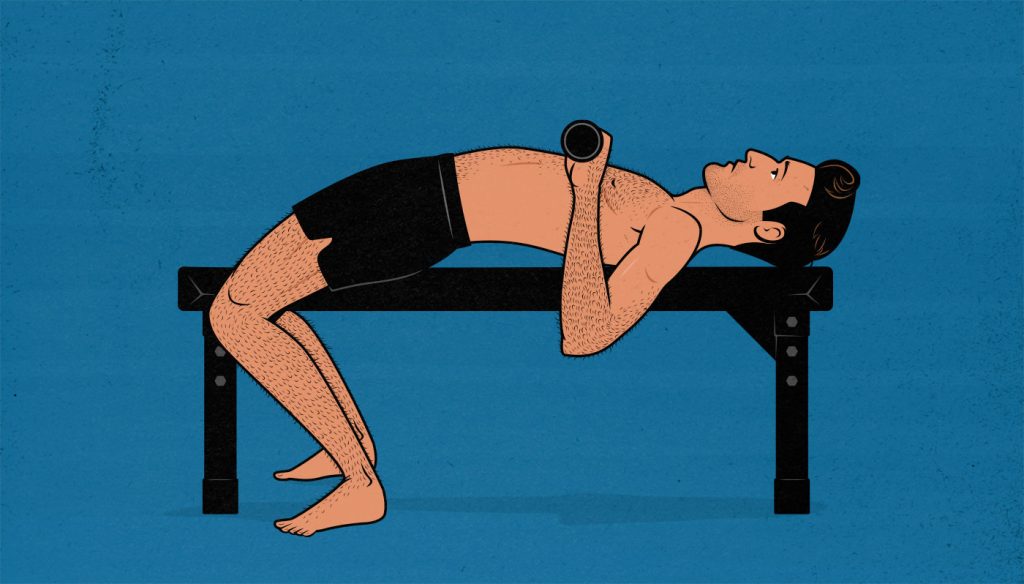
Ectomorph Workout Plan: Beginner Weight Training Routine
Skinny guys are often called “ectomorphs.” It’s a slang term referring to our thinner bones, narrower frames, shallower ribcages, or lankier limbs. Does being naturally thinner affect how we should exercise, lift weights, and build muscle?
Many of us ectomorphs also have atypical goals. Most people want to lose weight, we want to gain it. Most people intuitively eat too much food, we eat too little. We’re usually eager to bulk up, and we often have a hard time of it. Some may even worry they’ve got bad muscle-building genetics. Does that change how we should train?
Different workout programs are designed for people with different goals. Some, like CrossFit, are designed to improve our general fitness. Others, like Starting Strength and StrongLifts 5×5, are designed to improve our general strength. Still others, such as bodybuilding, seem entirely centred around helping naturally muscular guys gain even more muscle. What’s the best way to work out if we’re trying to gain muscle size?
So, how should ectomorphs work out?
- What is an Ectomorph?
- Does Being An Ectomorph Affect Our Training?
- Ectomorphs Can Build Muscle Fast
- Bodybuilding Versus Strength Training Versus Power Training
- The Principles of Hypertrophy Training
- The “Big 3” Strength Training Lifts for Ectomorphs
- The “Big 3” Hypertrophy Lifts for Ectomorphs
- A Sample Beginner Bulking Routine
- The Final Word
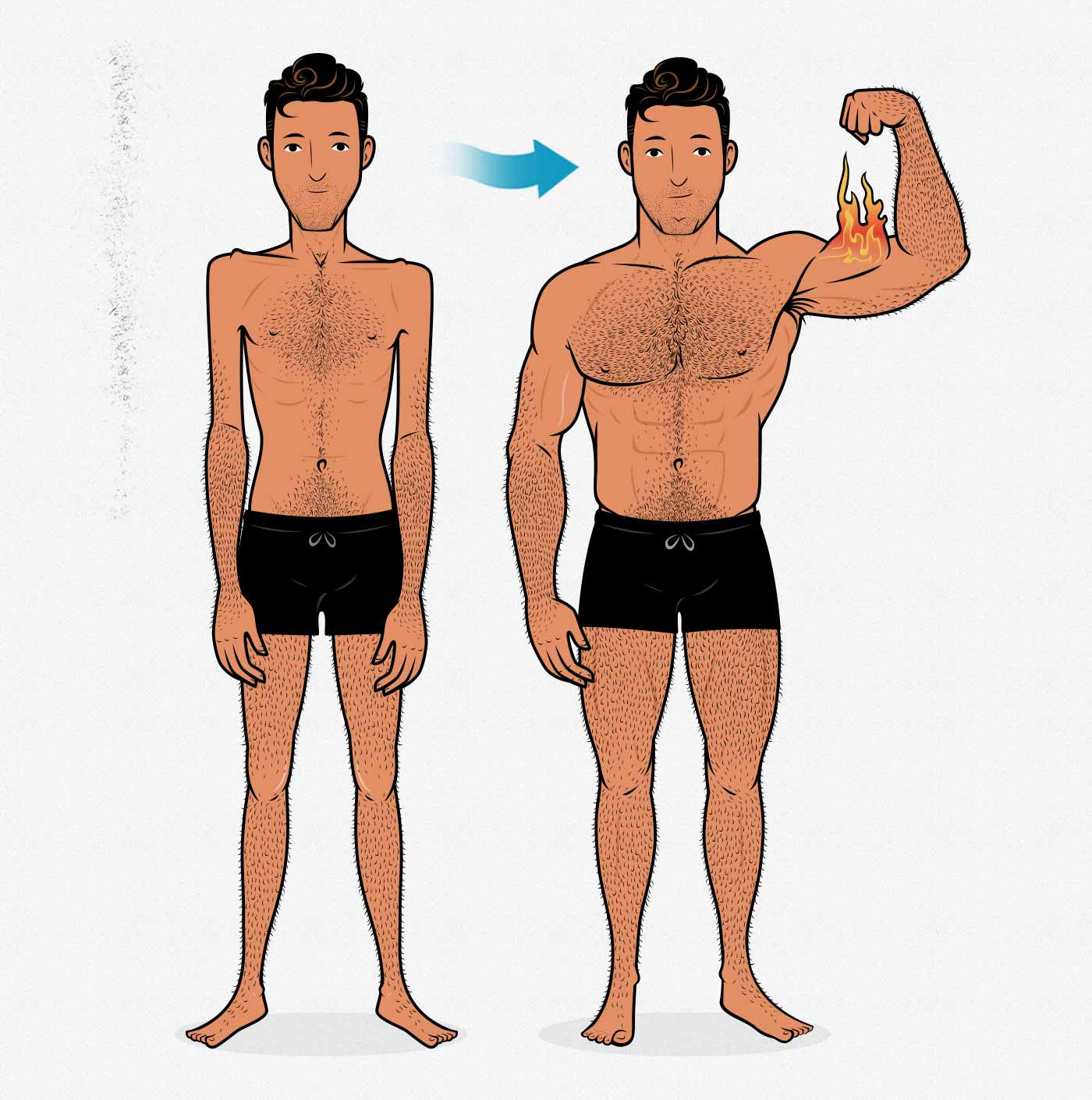
What is an Ectomorph?
Ectomorph is a term borrowed from old psychological pseudoscience. The psychological aspect of it was bunk, but the body types caught on in the bodybuilding community. Guys with stockier bone structures were called endomorphs, guys with broader shoulders were called mesomorphs, and guys with thinner frames were called ectomorphs.
Ectomorph is often used interchangeably with “hardgainer,” but we use that to refer to someone who has trouble eating enough calories to gain weight. Sometimes people mistake hardgainers for having bad muscle-building genetics, for being “low-responders” to resistance training. That’s a myth. Skinny guys can often build muscle quite fast.
Does Being An Ectomorph Affect Our Training?
There’s a reason the word “ectomorph” caught on like wildfire in the bodybuilding community. It’s a useful term when discussing workouts, or bulking diets, or adjusting our lifestyles for muscle growth. Here’s why:
- Not all skinny guys are ectomorphs. If an overweight person diets down, or if an athletic person gets sick, they might wind up skinny. But they tend to have different struggles from people who are naturally skinny.
- Not all ectomorphs are skinny. Many naturally skinny guys learn how to build muscle and bulk up. They still have thinner bone structures, but they’re strong and athletic. Some skinny guys gain fat, too, becoming skinny-fat.
- Ectomorphs often have different goals. Naturally skinny guys are often interested in getting bigger, stronger, and more muscular—we’re interested in bulking. Most people want to lose weight.
- Ectomorphs start off carrying less weight around with them. The average American man weighs 200 pounds (CDC), whereas I started off weighing 130 pounds. That means I was carrying around seventy fewer pounds up staircases. On the one hand, that’s an enormous advantage when doing some lifts, such as the chin-up and the push-up. On the other hand, my legs, hips, and spinal erectors were quite a bit weaker than the average man’s, and I found it quite hard to learn the squat and deadlift. These things can affect our training, at least at first.
- Ectomorphs have lankier limbs. Some guys can build big arms with bench presses and rows. That’s not the case for most ectomorphs. Most of us need biceps curls, triceps extensions, forearm curls, and so on.
- We often have thinner necks. The average man already has a 15–16.5″ neck (study). My neck started at 14″ and refused to grow until I started training it directly.
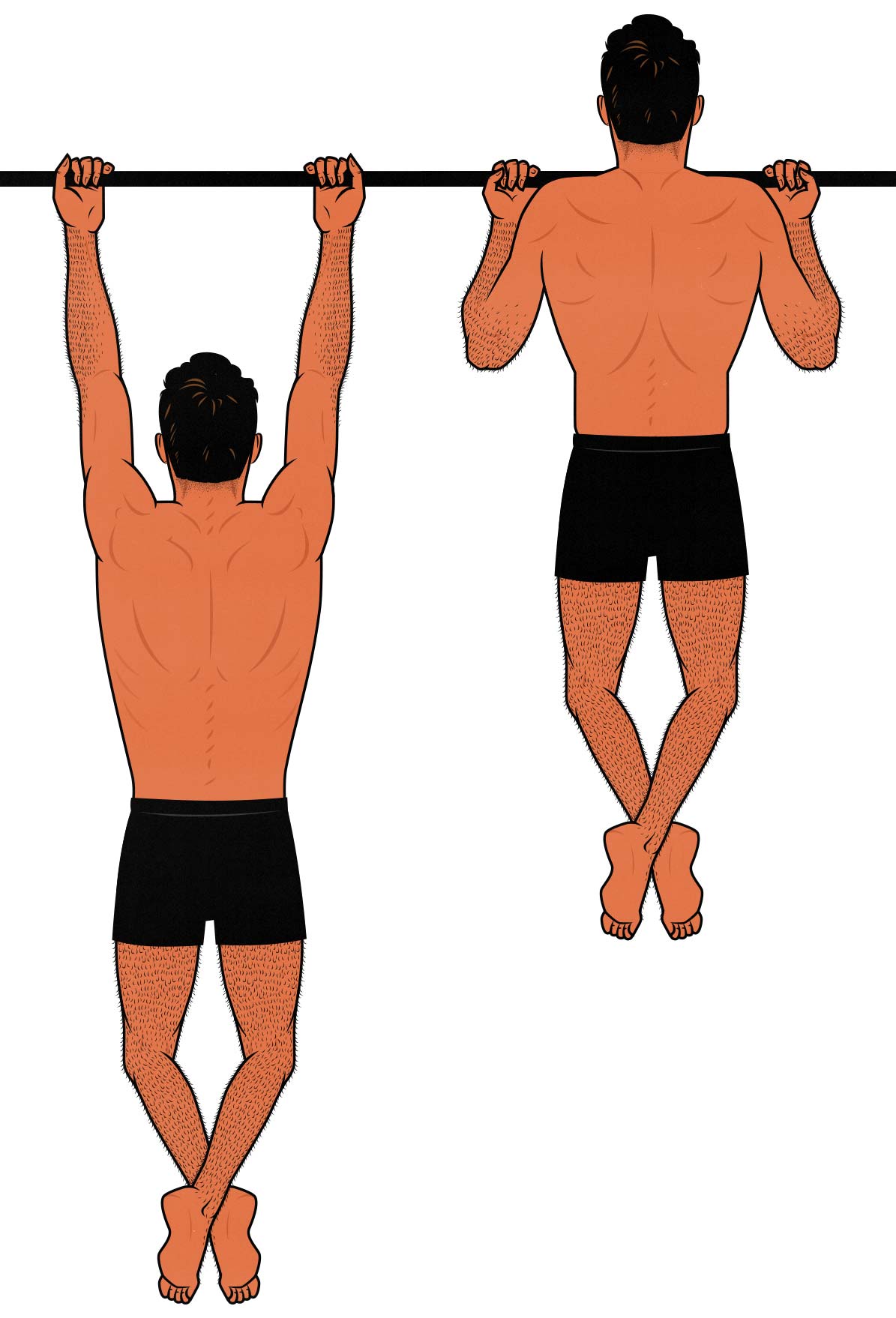
This isn’t an exhaustive list, but it shows that, sometimes, being an ectomorph can change how we approach weight training. Not all ectomorphs are exactly the same. Our starting points, circumstances, and goals can vary quite a bit. But most of us resonate with at least some of those points.
Ectomorphs Can Build Muscle Fast
Some ectomorphs enjoy being relatively thin. I don’t want to imply that every ectomorph ought to become muscular. But at least in my own case, I was clinically underweight, weaker than average, and desperate to become bigger, stronger, and healthier. To accomplish my goals, I needed to bulk up and build muscle.
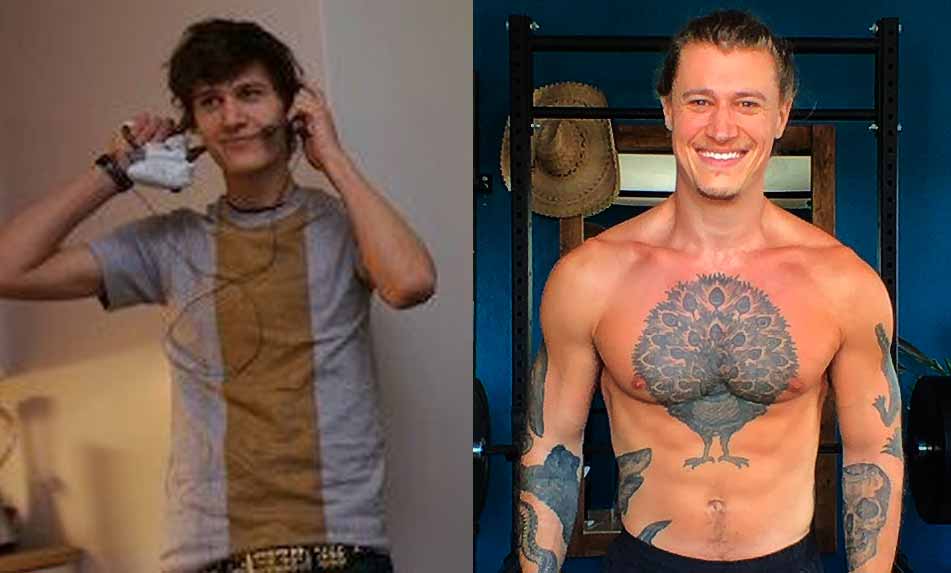
After years spent struggling to build muscle, I finally learned how to train and diet for muscle size, and I gained 55 pounds in a little over two years. Since then, I’ve gradually put on another 15 pounds.
While gaining those first 55 pounds, I guided my roommate, Jared, through a weight-training routine. He gained 27 pounds during his first four months of working out without gaining a noticeable amount of fat:
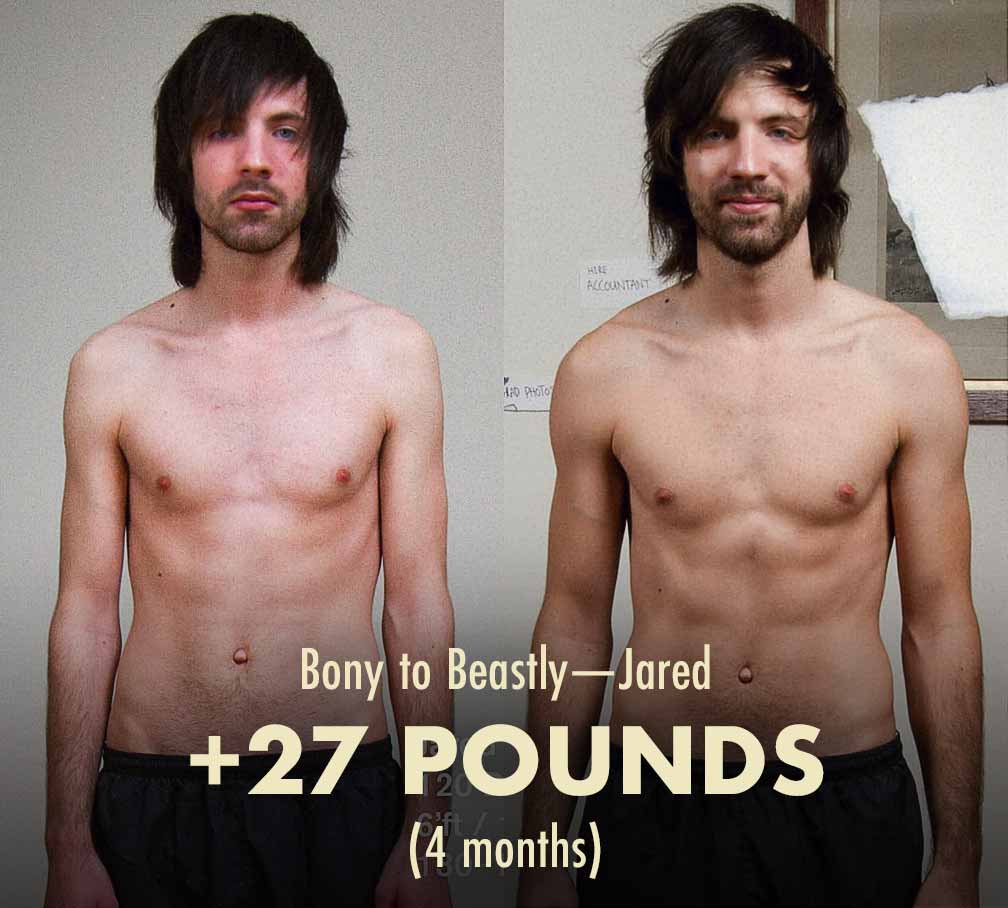
Meanwhile, our strength coach, Marco, had gained nearly 70 pounds, gotten his Health Sciences degree (BHSc) and strength coach certifications (PTS), and was helping college, professional, and Olympic athletes bulk up. Many of his clients, especially the volleyball and basketball players, were naturally skinny “ectomorphs” who had difficulty putting on mass—the same struggle Marco had. Helping people bulk up became his specialty.
The three of us created Outlift, Bony to Beastly, and Bony to Bombshell, all dedicated to helping skinny people build muscle. During these past ten years, we’ve helped over 10,000 naturally skinny people bulk up.
Being naturally skinny is largely genetic, too. It’s heritable. We come from families full of skinny people. My mother was called a “mop” in high school. My dad was 6′ and 100 pounds. My little sister had to bulk up to get to a healthy body weight.

In our experience, most of us want to be strong, muscular, attractive, and healthy. And those are realistic goals. Not only can we build muscle, but as we’ve just shown, we can often do it rather quickly. In fact, we have a few factors acting in our favour:
- There’s a law of diminishing returns that kicks in as we build muscle. But since we’re further away from our genetic muscular potential, we get that effect in reverse. This is often called “newbie gains.”
- As we lift weights, we grow bigger, stronger, and also tougher. Our increasing toughness is called the repeated bout effect (RBE), and it means that as we continue to build muscle, it becomes harder to provoke more muscle growth. But since we’re new to lifting weights, our muscles are still very responsive to our workouts.
- Many of us are naturally leaner, meaning that we can gain weight more quickly without worrying as much about gaining fat. That doesn’t mean we should intentionally gain fat, just that we can often build muscle quite fast without gaining a noticeable amount of it. And even if we do gain fat, it melts off by itself anyway.
These factors combine together to allow most ectomorphs to build muscle quite fast, especially when they’re new to bulking. That doesn’t mean that all of us can build muscle faster than the average person, but we’ve coached thousands of guys through their bulks, and it’s incredibly common.

The catch is that we need to train for muscle growth. Most of us have naturally less muscle mass. We can’t do CrossFit, burn some fat, and expect to come out looking muscular. Some overweight people can get away with that. Most of us cannot. We can’t chisel away our fat to reveal our muscles. There are only bones waiting underneath. Our abs are made in the gym, not the kitchen.
This is why ectomorphs need to train differently from the average person. It’s not because we’re bad at building muscle. It’s because we want to prioritize building muscle. We don’t just want to get stronger for our size, we want to get bigger and stronger. That’s a special style of training.
Bodybuilding Versus Strength Training Versus Power Training
When some people talk about how to train for muscle growth, they call it “bodybuilding.” But bodybuilding has a unique culture full of spray trans, speedos, clean eating, and more calf training than neck training. Not all bodybuilding is that way, but it’s a term lugging around quite a lot of baggage.
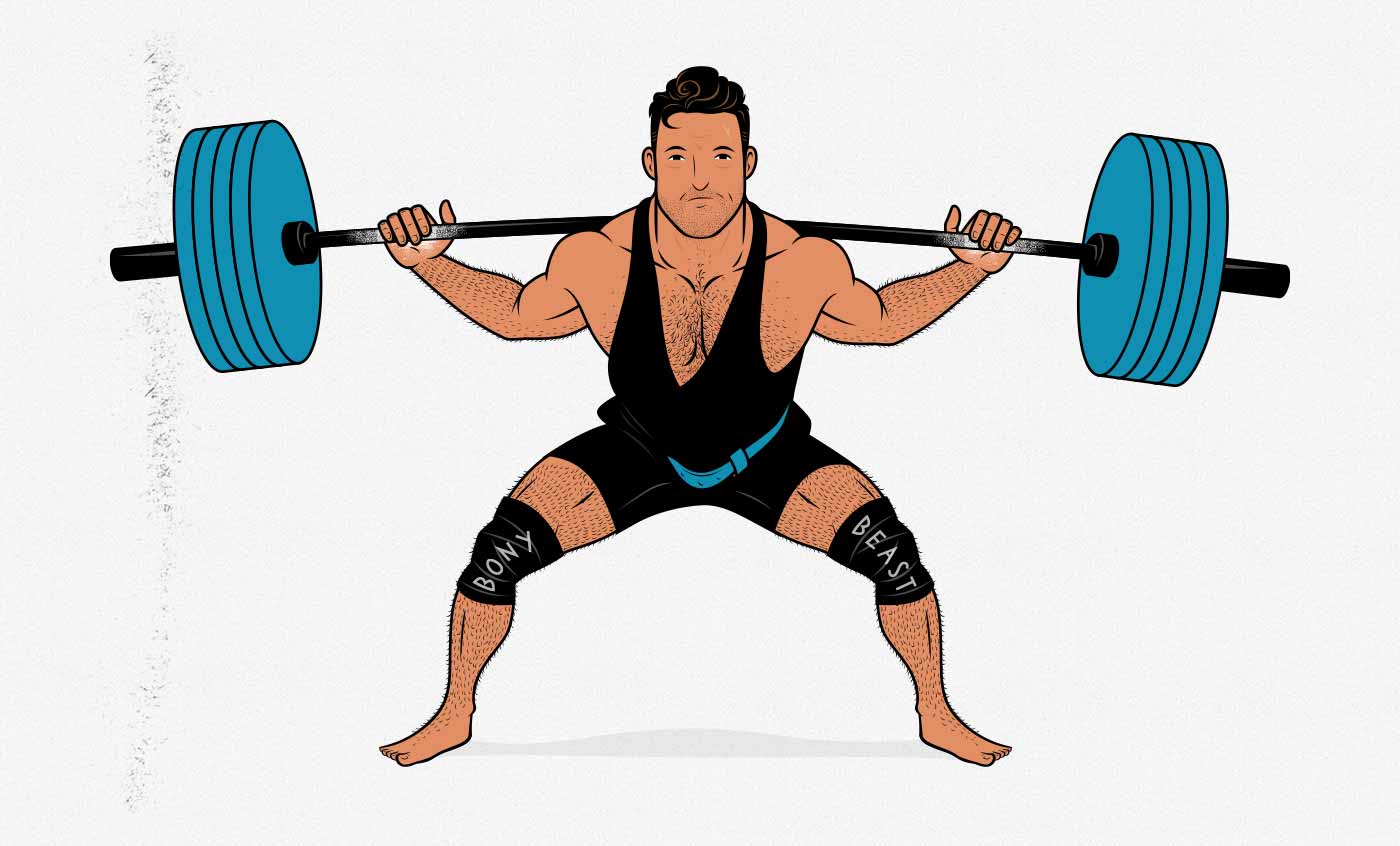
Other people call any sort of resistance training “strength training.” But again, strength training has its own unique culture, typically rooted in powerlifting. As such, strength training routines are usually built around the “big three” lifts, the rep ranges tend to be pretty low, the lifts are chosen for the leverage they provide, and isolation lifts are scowled upon.
Not all strength training programs are that way, but Starting Strength and StrongLifts 5×5 are. And besides, even just the meaning of the word implies that the main goal is to gain strength instead of size.
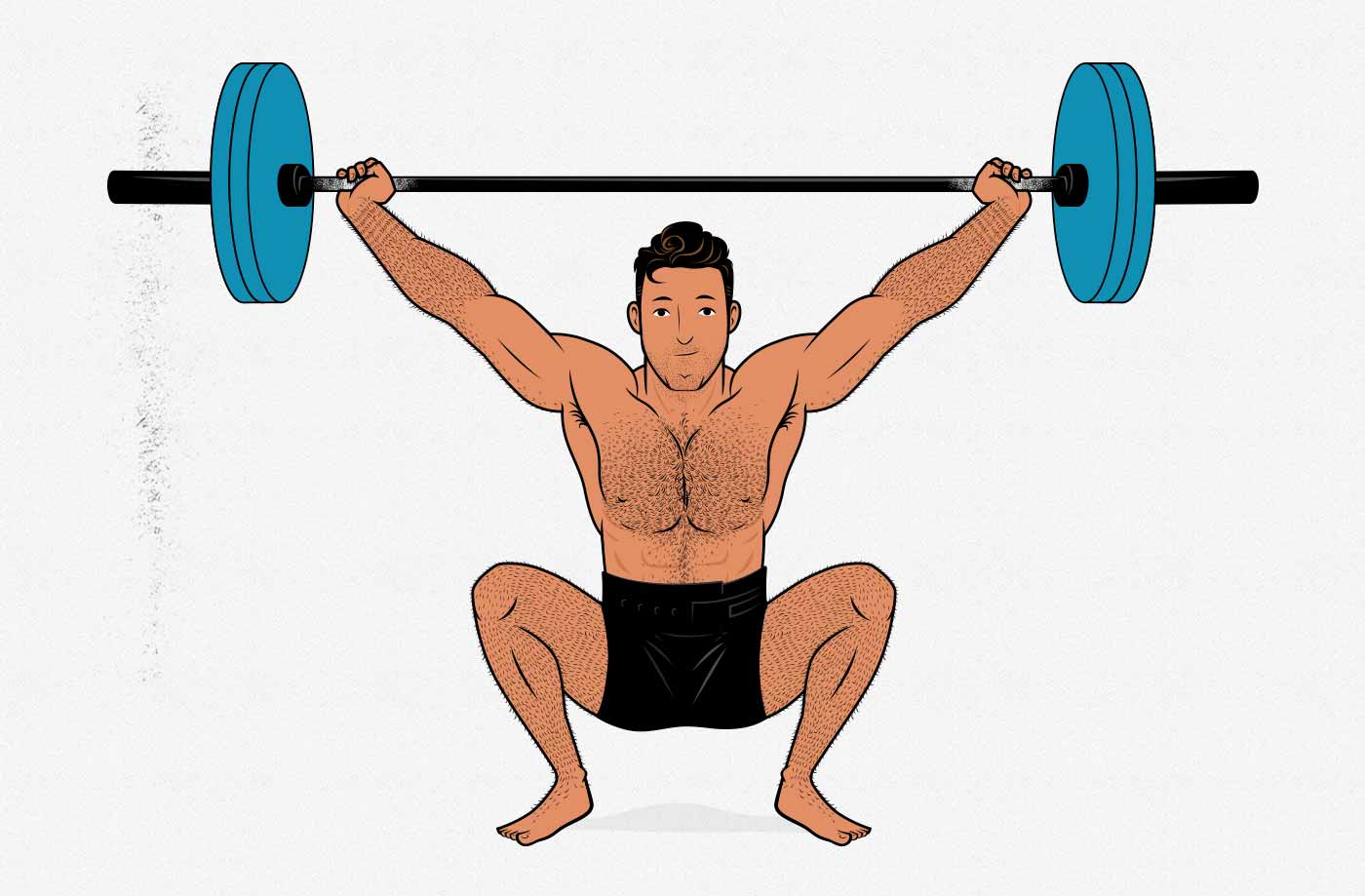
That brings us to another type of training that people often use to build muscle: power training. The most popular brand of power training is CrossFit, a blend of Olympic weightlifting and general fitness training, giving it the categorization of high-intensity power training (HIPT). It’s a great form of exercise. It’s just not designed to stimulate muscle growth. It’s better for our cardiovascular systems than our muscles.

What we need is hypertrophy training. “Muscle hypertrophy” means muscle growth. Hypertrophy training is training designed to stimulate muscle growth. The best way to build muscle is to train for it.
The Principles of Hypertrophy Training
Hypertrophy training has no speedos or spraytans, no powerlifting meets or 1-rep max tests, and no kipping pull-ups until our muscles fall off. There are many different hypertrophy training programs. There’s no single best approach. But even so, most hypertrophy training programs are built around a few key principles:
- Working out with free weights is usually best. It’s possible to build muscle with bodyweight hypertrophy training, but free weights make building muscle much easier. Doing most of your training with dumbbells or a barbell is ideal. If you have access to cables and machines, you can mix those in.
- The lifts should match your strength and skill level. Not only does that make our training safer, but it also allows us to stimulate more muscle growth. For instance, front squats are amazing for building muscle, but most beginners can’t do them. Instead of trying to force it, choose a simpler variation, such as a goblet squat. You’ll be able to work your muscles harder, you’ll learn how to squat, and you can switch to front squats later.
- The lifts should be chosen for their ability to stimulate muscle growth. Choose lifts that challenge your muscles under a deep stretch. Ones that stress your muscles instead of your joints. Use a mix of classic strength training lifts, such as bench presses, deadlifts, and chin-ups, as well as some classic bodybuilding lifts, such as triceps extensions and biceps curls.
- Use a mix of compound and isolation lifts. There’s no doubt that the big compound lifts stimulate the most overall muscle growth, and for stocky people, that may be good enough. But compound lifts don’t challenge all of our muscles enough to stimulate much growth. For instance, the bench press isn’t very good for bulking up our triceps (study), the barbell row isn’t very good for bulking up our biceps (study), and the deadlift isn’t very good for bulking up our hamstrings. That’s where isolation lifts come in.
- We should do most of our lifting in moderate rep ranges. Moderate rep ranges stimulate more muscle growth than lower rep ranges (systematic review), so we can build muscle more easily by spending most of our time lifting between 6–20 reps, probably favouring more like 8–15 reps, and occasionally going as wide as 4–40 reps.
- We can use a mix of longer and shorter rest periods. When doing big compound lifts in moderate rep ranges (6–12 reps), our cardiovascular systems can be worked quite hard. It can help to rest 2+ minutes between sets to give our cardiovascular systems enough time to recover, allowing us to lift heavy on subsequent sets. That way, we gain muscle size and strength instead of just improving our cardio. But when doing smaller isolation lifts, our cardiovascular systems won’t be challenged as much, giving us an opportunity to use higher rep ranges (10–20 reps) and shorter rest times (30–90 seconds) to increase our muscle growth by “pumping” in a bunch of local growth factors.
- Train each muscle 2–3 times per week. Most research shows that we can gain muscle the fastest by training all of our muscles 2–3 times per week (study). This is because a workout stimulates around 48 hours of muscle growth, meaning that we can stimulate a new wave of growth every second day—three times per week. The most efficient way to do this is to do three full-body workouts per week, but other approaches are effective as well.
- Our training volume should be reasonably high. Do a few sets for each muscle group each workout (study).
- Train close to failure. Most research shows that if you stop lifting just before your muscles give out, you’ll still build just as much muscle as if you went all the way to failure (study). However, most research on novice lifters shows that training to failure stimulates slightly more muscle growth (study, study). A good solution, then, is to stop shy of failure on our big compound lifts but to take some of our isolation lifts to failure, especially on the final set of each exercise.
- Lift explosively, lower under control. The lifting and lowering portion of the lift both stimulate muscle growth, so we should make the most of both. We don’t want to jerk or throw the weights, but we do want to accelerate them, engaging our muscles fully right from the beginning of the lift.
- Focus on progressive overload. The trick to getting bigger and stronger over time is to have a programmed workout routine. Write down how much weight you’re lifting, how many reps you’re able to get, and how many sets you’re doing. In your next workout, try to lift more weight, do more reps, or add more sets.
This makes our hypertrophy workouts look quite a bit different from strength training, CrossFit, and even most bodybuilding workouts (although good bodybuilding workouts will use most of these principles). Our bulking program does all of this, but it’s not the only one. There are a lot of good bulking programs out there.
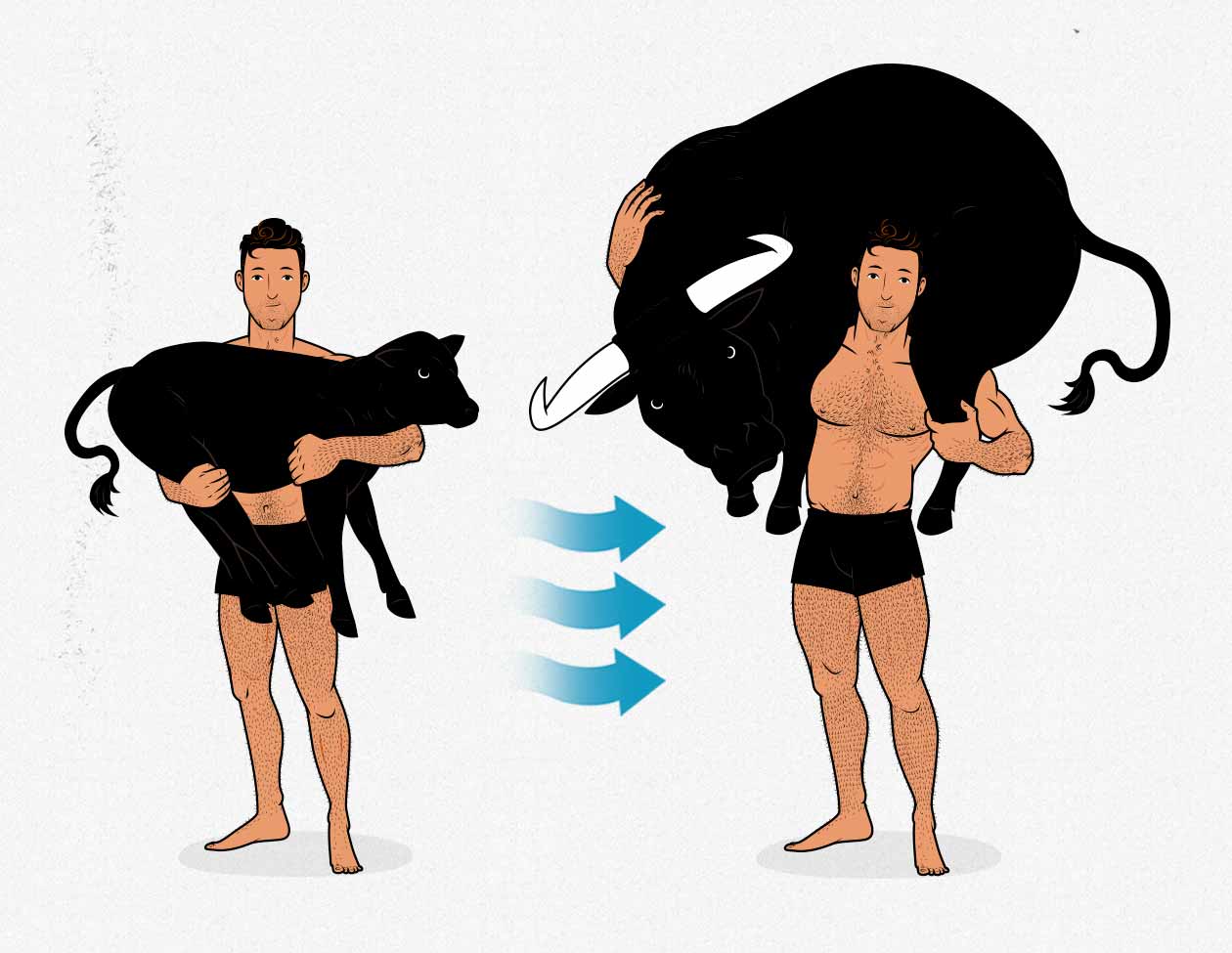
The “Big 3” Strength Training Lifts for Ectomorphs
As we’ve covered above, there’s a difference between strength training and hypertrophy training. Strength training is usually rooted in powerlifting culture, and it’s built around the Big Three powerlifting lifts: the low-bar squat, bench press, and deadlift.
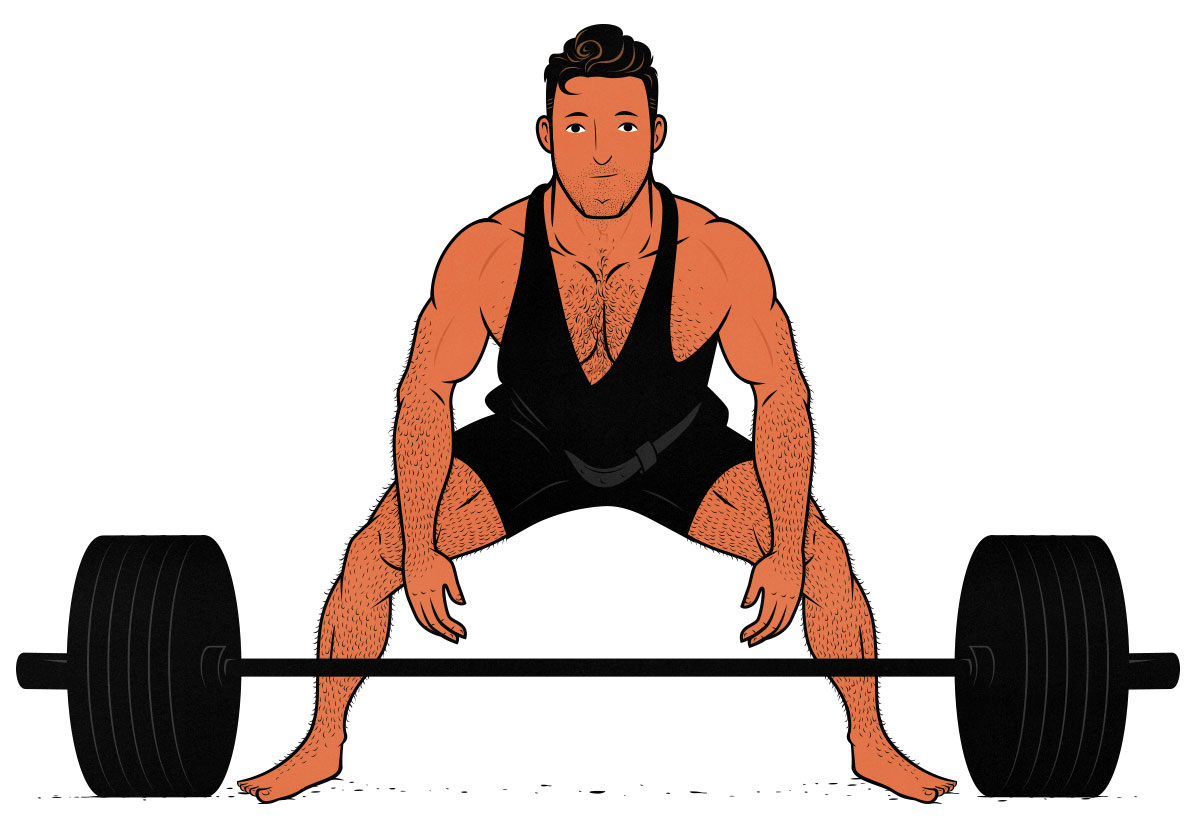
Ectomorphs aren’t really built for powerlifting. It’s a sport dominated by thickly built people. But we aren’t necessarily bad at it, either. One of the best powerlifters of all time is a thinly built guy named Lamar Gant. He deadlifted over 600 pounds at a bodyweight of 120 pounds.
If our goal was to lift as much weight as possible, we could make the most of our proportions by adjusting the powerlifting lifts like so:
- Deadlifting with a wide sumo stance so that we can maintain a more upright torso. This allows us to take advantage of our longer arms while making it easier to stabilize our thin torsos. However, sumo deadlifts aren’t as good for bulking up our backs, making them a poor choice when trying to build muscle. For building muscle, conventional deadlifts tend to be better.
- Squatting with a wide stance and a low-bar position. Again, this minimizes the back strength we need, and it allows us to leverage our strong hip-extensor muscles (such as our glutes and adductors). This makes the squat more similar to a sumo deadlift, allowing us to lift more weight and have greater overlap between our lifts. However, again, it’s not a great way to stimulate growth in our spinal erectors, it’s not the safest way to squat, and it doesn’t work our quads through as deep of a range of motion. For building muscle, front squats and high-bar squats tend to be better.
- Bench pressing with an ultra-wide grip. The wider we grip the barbell, the more we can minimize the range of motion and minimize the moment arms at our shoulders. However, it removes our triceps, upper chest, and shoulders from the lift. For building muscle, it’s usually better for us to bench with a moderate grip width, use a larger range of motion, and then add in the dumbbell fly if we want extra stimulation for our mid and lower chest muscles.
So what we’re seeing is that powerlifting is all about choosing the lifts that reduce the demands on our long limbs and reduce the range of motion, thus allowing us to best leverage our strengths. But if we’re trying to build muscle, we want to do almost the exact opposite of that. We want to give our lanky limbs extra attention, use the deepest range of motion we can manage, and bring up our weaknesses.
The “Big 3” Hypertrophy Lifts for Ectomorphs
When we first start working out, we don’t have the strength or experience of seasoned lifters. Most of us don’t have the mobility to squat deeply, the strength to do deadlifts or barbell rows without rounding our lower backs, or the shoulder stability to do barbell overhead presses. For a lot of skinny beginners, it’s even a struggle to set up in a sturdy bench press position and bring the barbell all the way down to our chests.

Some people, with some coaches, can learn the lifts right from their very first workouts. Most of us cannot. To build muscle at full speed, we need to be able to take our lifts at least somewhat close to muscular failure. That means choosing lifts we can properly challenge our muscles with. Then, as we grow bigger and stronger, we can progress to more advanced variations.
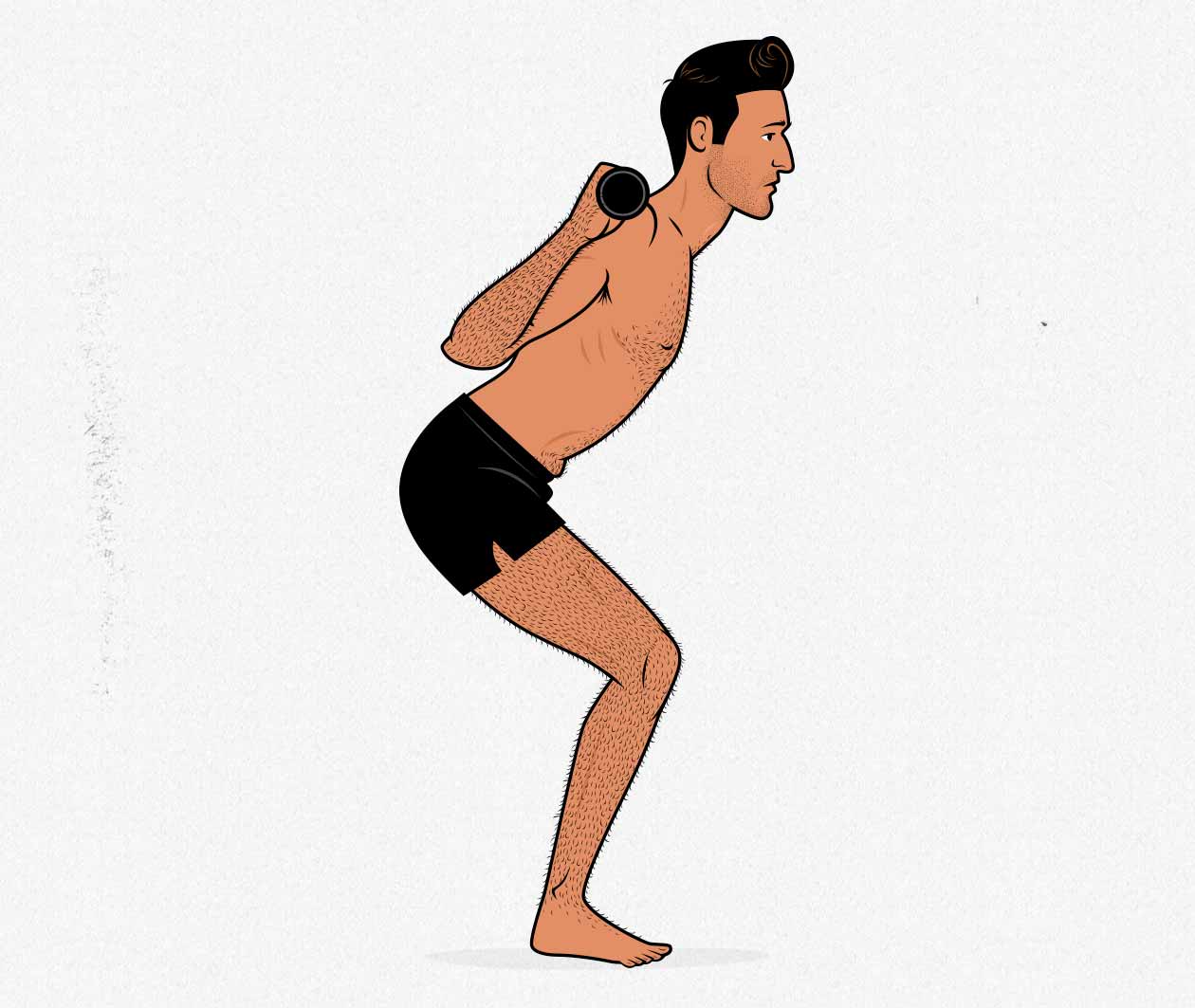
Most coaches use proper exercise progressions. Most online programs don’t. So let’s talk about how to adjust the big compound lifts so that a skinny ectomorph can safely build muscle at full speed right from his very first workout.
How to Bench Press as an Ectomorph
The bench press is the very best lift for building a bigger chest, it’s an amazing lift for bulking up the fronts of our shoulders, and it’s somewhat okay for building bigger triceps. Some of us can do it properly the very first time we try it, but the bench press tends to be a hard lift for a lot of ectomorphs. Most of us have long arms, thin ribcages, and haven’t built much muscle size, strength, or coordination yet. It would be great if we could set up in a powerful bench press position… but sometimes we can’t.
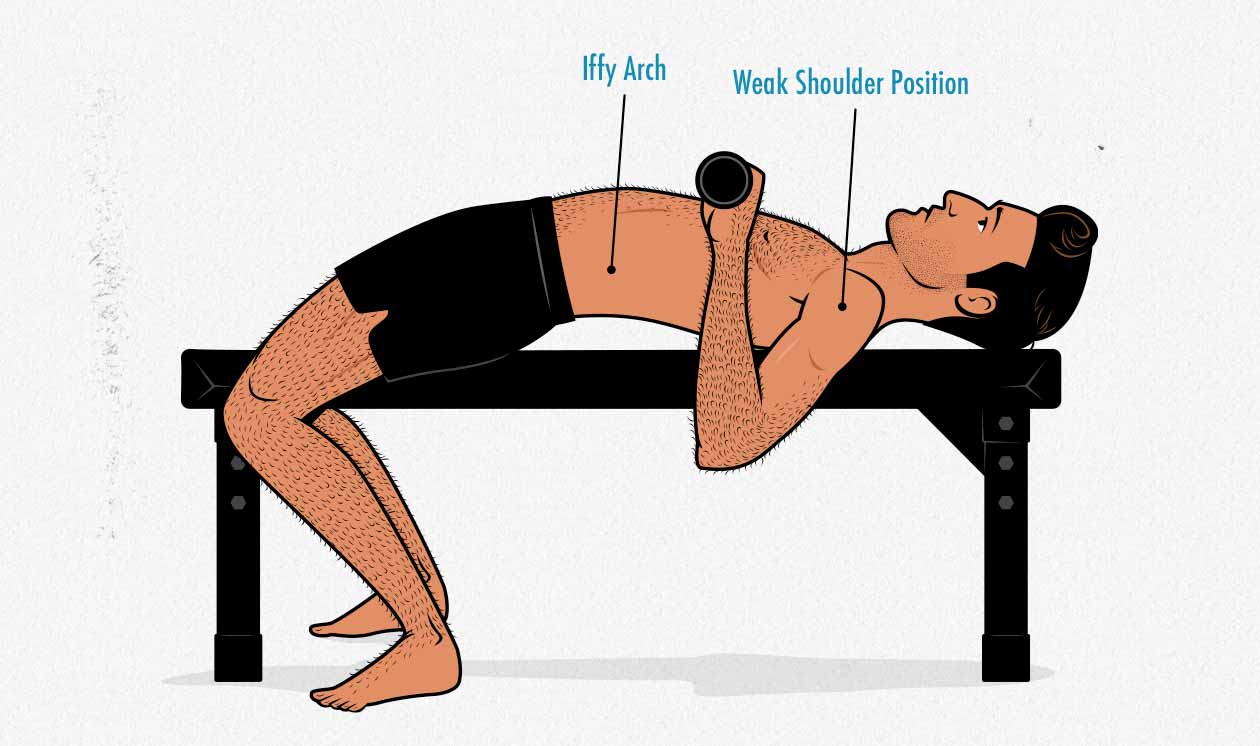
Most ectomorphs look something like this the first time we try to bench press. Not all of us are this thin, but I sure was, and by the time the barbell touched my chest, my elbows were almost touching the floor. Lifting with a larger range of motion is often a good thing, but we also need to make sure that we’re lifting from a sturdy position that’s safe for our shoulders. When our elbows move that far past our torsos, especially if our shoulders aren’t very strong yet, and especially if our technique isn’t very good yet, it can limit the amount of weight we can use and it can be hard on our shoulders. That’s not a great combination for building muscle.
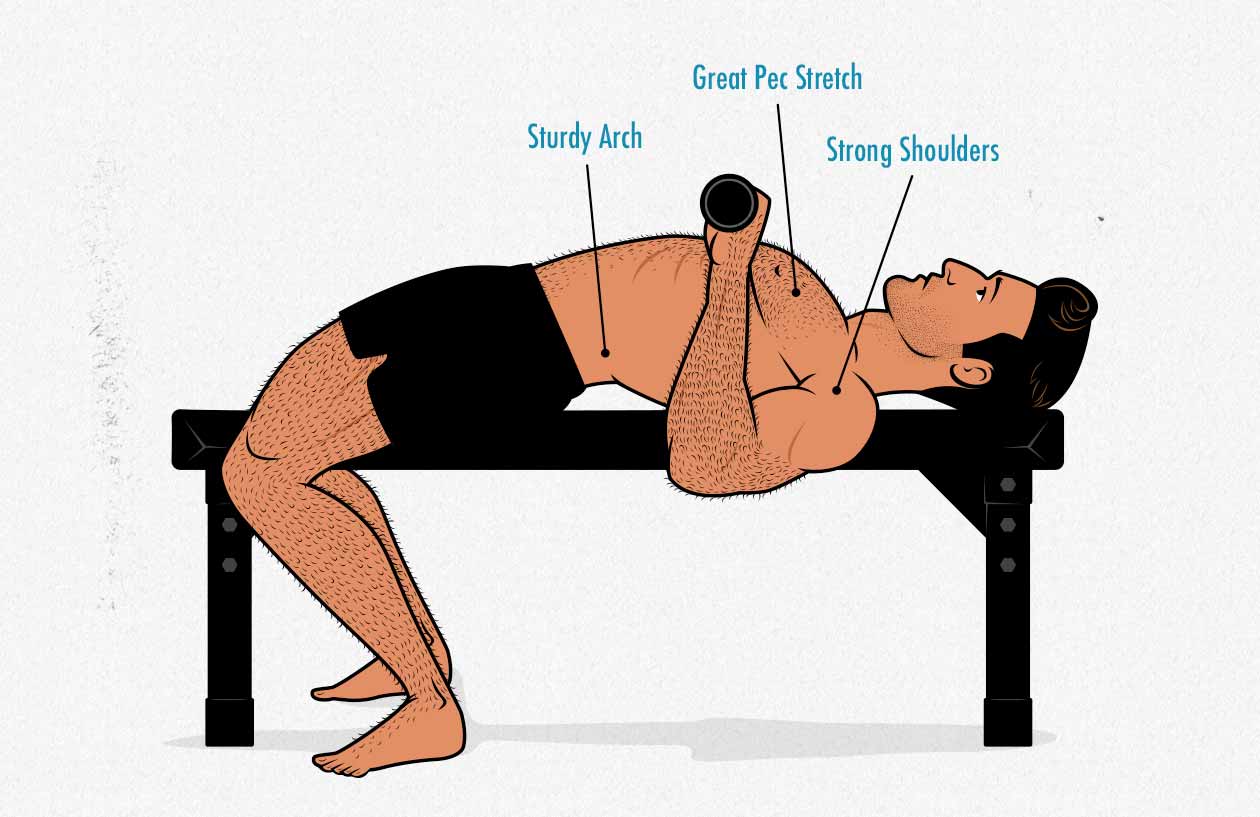
That doesn’t mean we should avoid the bench press. Once we pack some muscle onto our chests and upper backs, improve our arches, and learn how to retract our shoulder blades, we’ll be able to bench with a much better shoulder position. At that point, our thin ribcages become an advantage. It allows us to get a better stretch on our pecs at the bottom of the lift, stimulating extra growth in our chests.

Ectomorphs aren’t necessarily bad at the bench press, either. Lamar Gant was able to break a world record on the bench press despite having incredibly long and lanky arms. He just worked really hard to build a bigger arch and improve his leverage. It’s not that it’s a bad lift for us, it’s just that we often benefit from starting with something easier, such as the push-up.
Push-ups are just as good as the bench press for stimulating muscle growth (study), especially for new lifters. They have the added benefit of training our abs and serratus muscles at the same time, making them a better bulking lift overall (for beginners). You can do them instead of the bench press or in addition to the bench press.
Here’s how to do the push-up:
If push-ups from the floor are too hard, you can raise your hands up on a bench or do them from your knees. If they’re too easy, you can raise your hands up on push-up handles, weight plates, or speculative fiction novels to enhance the stretch. You can also add weight plates to your back, wear a backpack full of cheap thriller novels, or wear a weighted vest. By the time you can do 20–30 deficit push-ups with good technique, you’re more than ready for the bench press.
There are a few different ways to build a bigger chest while learning how to do the bench press:
- Push-ups: as covered above, starting with push-ups is one of the best ways to build a big chest while preparing your body for a strong bench press. It’s just as good for stimulating muscle growth and the strength transference between the two lifts is almost perfect.
- The dumbbell bench press: the advantage of dumbbells is that allow they allow us to use a comfortable range of motion instead of forcing us to bring the barbell all the way down to our chests. For some people, the dumbbell bench press can be even easier to learn than the push-up.
- The board press: by placing boards on our chests, we can mimic having a thicker ribcage. This can help to keep our shoulders in a stronger position as we develop strength in deeper ranges of motion. You can start with thicker boards and gradually work your way down to thinner ones, eventually getting rid of them altogether. The reason we want to use boards instead of just reversing the barbell in midair is twofold. First, we want our technique to be consistent from rep to rep and from workout to workout. Second, it’s risky to bench press when you can’t control the full range of motion. If you get too tired or accidentally go a bit too deep, your muscles won’t be able to control that bottom part. (Also, make sure to bench press with safety bars or a competent spotter.)
- Add in the dumbbell fly: the thing that makes the bench press so great for building muscle is that it allows us to train our chests under a heavy stretch at the bottom of the movement. But if we aren’t benching deep, we aren’t getting that benefit. Fortunately, the dumbbell fly is a simple lift that gives us that same effect. It will also help to strengthen our shoulder joints in a safe way (provided that it’s done correctly).
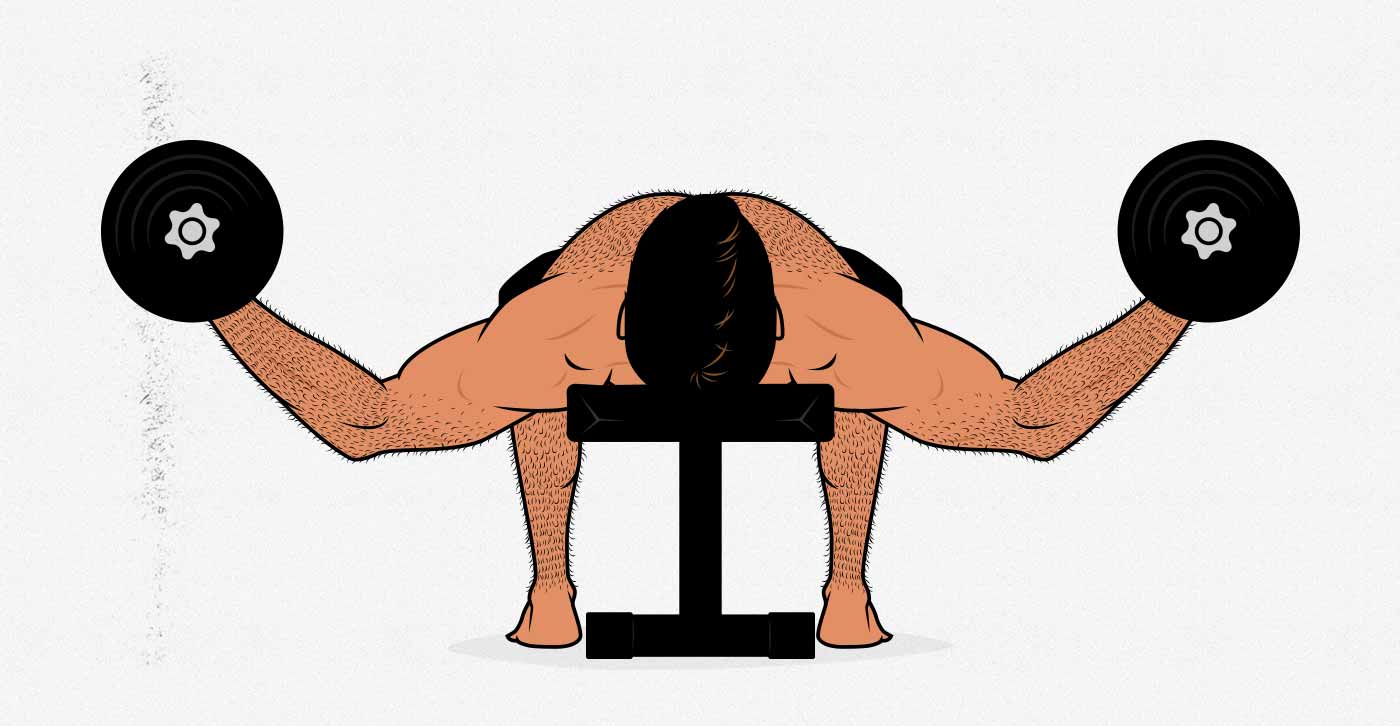
How to Deadlift as an Ectomorph
The conventional deadlift is the best lift for stimulating overall muscle growth, bulking up our hips, hamstrings, spinal erectors, traps, and, albeit to a minor extent, our forearms. For stocky people with shorter and thicker torsos, the deadlift tends to be a hip-dominant lift, with most of the muscle growth going to the glutes and hamstrings. For us ectomorphs, most of us have thinner spines that are harder to stabilize, and so the deadlift becomes a back-dominant lift, with most of the growth going towards our spinal erectors.
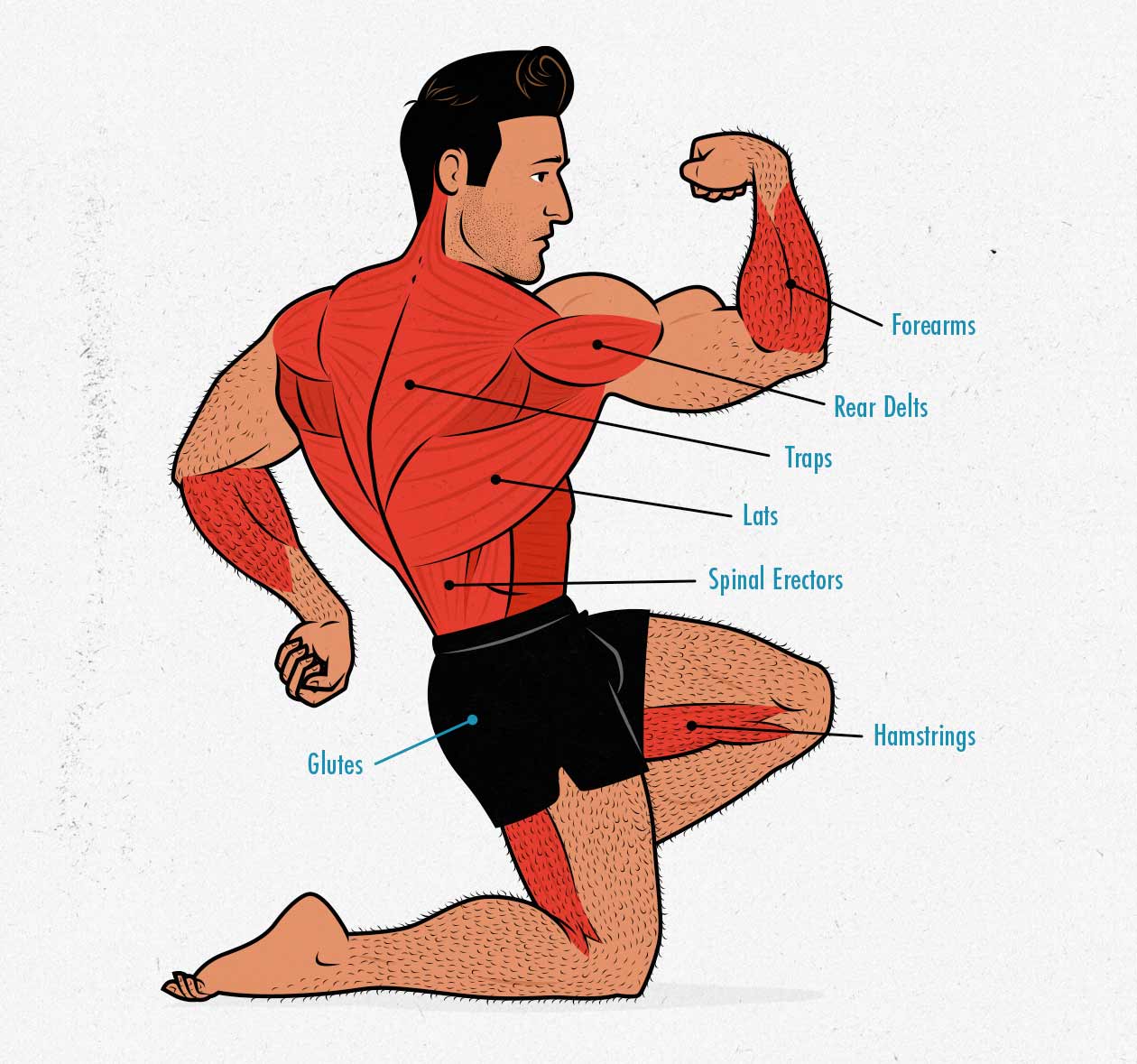
The deadlift is a movement pattern called a “hip hinge,” where we bend at the hips while keeping our spines locked in a neutral position by bracing our cores and tensing our spinal erectors. That’s the idea, anyway. When most of us try to pick the bar up, it winds up looking something like this:
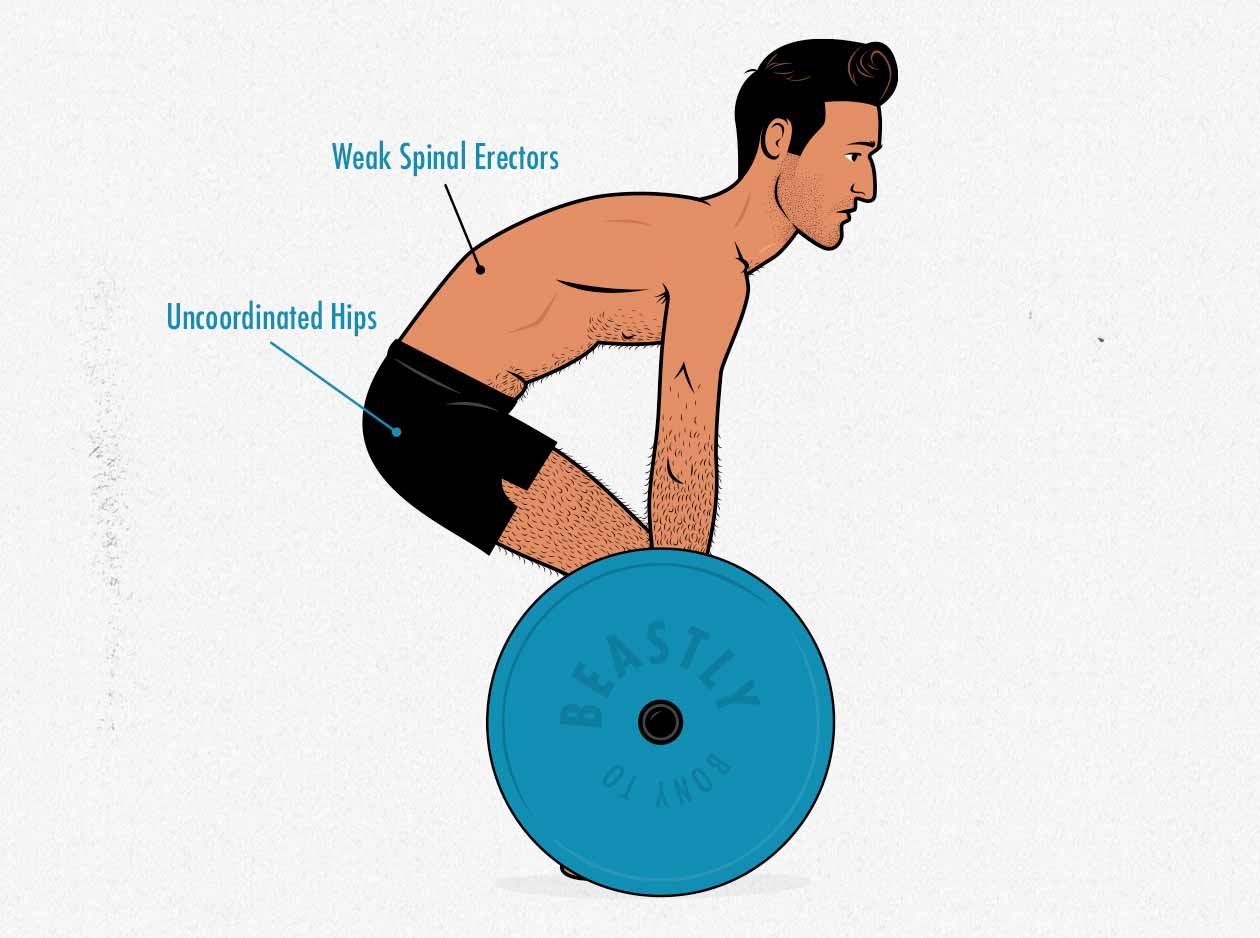
The deadlift has a rough learning curve. It’s one of the hardest movements for a beginner to learn. It’s even harder if you have a long torso and weak spinal erectors. It’s not that it’s a dangerous lift, it’s just that we need to do it correctly, which is hard.
We could avoid the problem by avoiding the deadlift, and many of us do. But then our spinal erectors will stay weak, and weak spinal erectors can be a real handicap when lifting weights. It’s also nice to build a pleasantly thick, strong back.
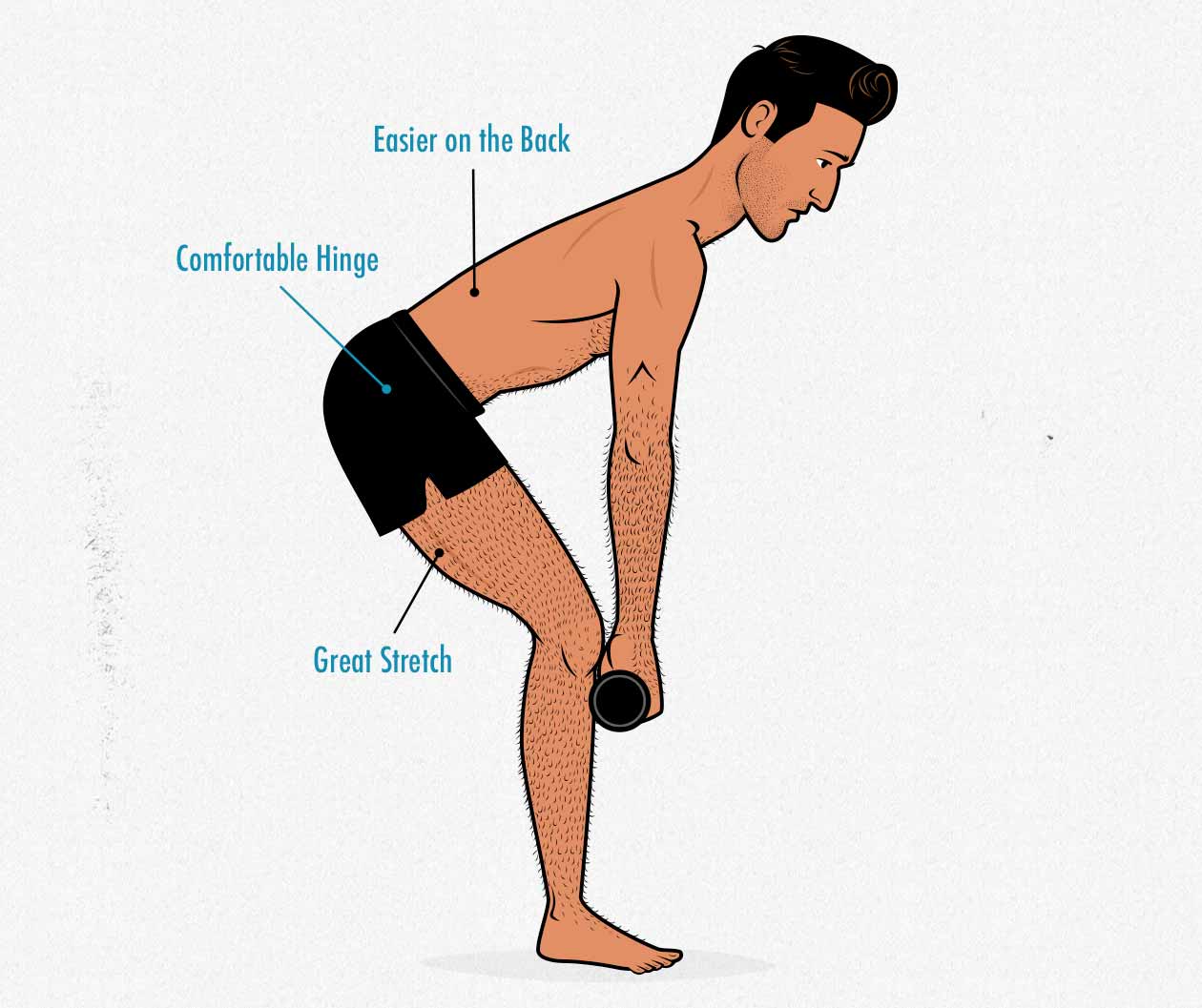
Fortunately, there’s a fairly simple fix: the stiff-legged “Romanian” deadlift. Instead of starting bent over, we start in a standing position. It’s more intuitive to brace and set up a neutral spine when we’re standing. From there, we stick our butt back while maintaining the brace and keeping our knees somewhat stiff. We lower it down until we feel a nice stretch on our hamstrings, at which point we lift the weight back up. It’s still a bit awkward to learn, but it’s much easier than the deadlift.
The Romanian deadlift also has the advantage of being absolutely brilliant for building muscle. It challenges our hamstrings and glutes in a stretched position, it allows us to use a great lifting tempo, it works well in moderate rep ranges, and we can keep constant tension on our muscles throughout the entire range of motion. In fact, it’s such a good lift for stimulating muscle growth that many advanced bodybuilders prefer them to conventional deadlifts, especially when trying to target their hamstrings.
Here’s how to do the Romanian deadlift with a barbell:
Here are some good beginner progressions for the deadlift:
- The dumbbell sumo deadlift: a great way to learn how to pick up a weight from the floor with a proper hip hinge. The downside is that it’s quite light, making it good for rank beginners, but progression will need to come quick muscle growth will grind to a halt.
- The stiff-leg “Romanian” deadlift: a great muscle-building lift for everyone at every level that can be done with dumbbells or barbells. It’s especially useful for novices who are struggling with their deadlift technique because it makes learning the hip hinge movement much easier.
- The below-the-knee rack pull: when we’re ready to start practicing lifting a barbell from the floor, it can help to raise the barbell up a little bit. That way we can warm up with lighter weights instead of needing to start with 135 pounds. It also reduces the range of motion we need in our hips, making it easier to maintain a neutral spine. And because we can maintain a slightly more upright torso, the demands on our spinal erectors are proportionally lower. (Make sure to lower the weight down slowly, though. If you drop a heavy barbell on the safety pins, it can damage the barbell.)
- The raised deadlift: if you’re having trouble keeping a neutral spine when doing deadlifts from the floor, try raising the barbell up by a few inches, opening up your hip angle a little bit. Over the course of a few weeks, you can then gradually lower the barbell down to the floor.
How to Squat as an Ectomorph
The low-bar back squat is a great lift. It’s the heaviest squat variation and it fully engages our hips and quads. But it’s not the best squat variation for building muscle. After all, it’s designed for powerlifting, not bodybuilding. It’s designed to maximize our leverage and minimize our range of motion, not to help us squat deeper or challenge our muscles.
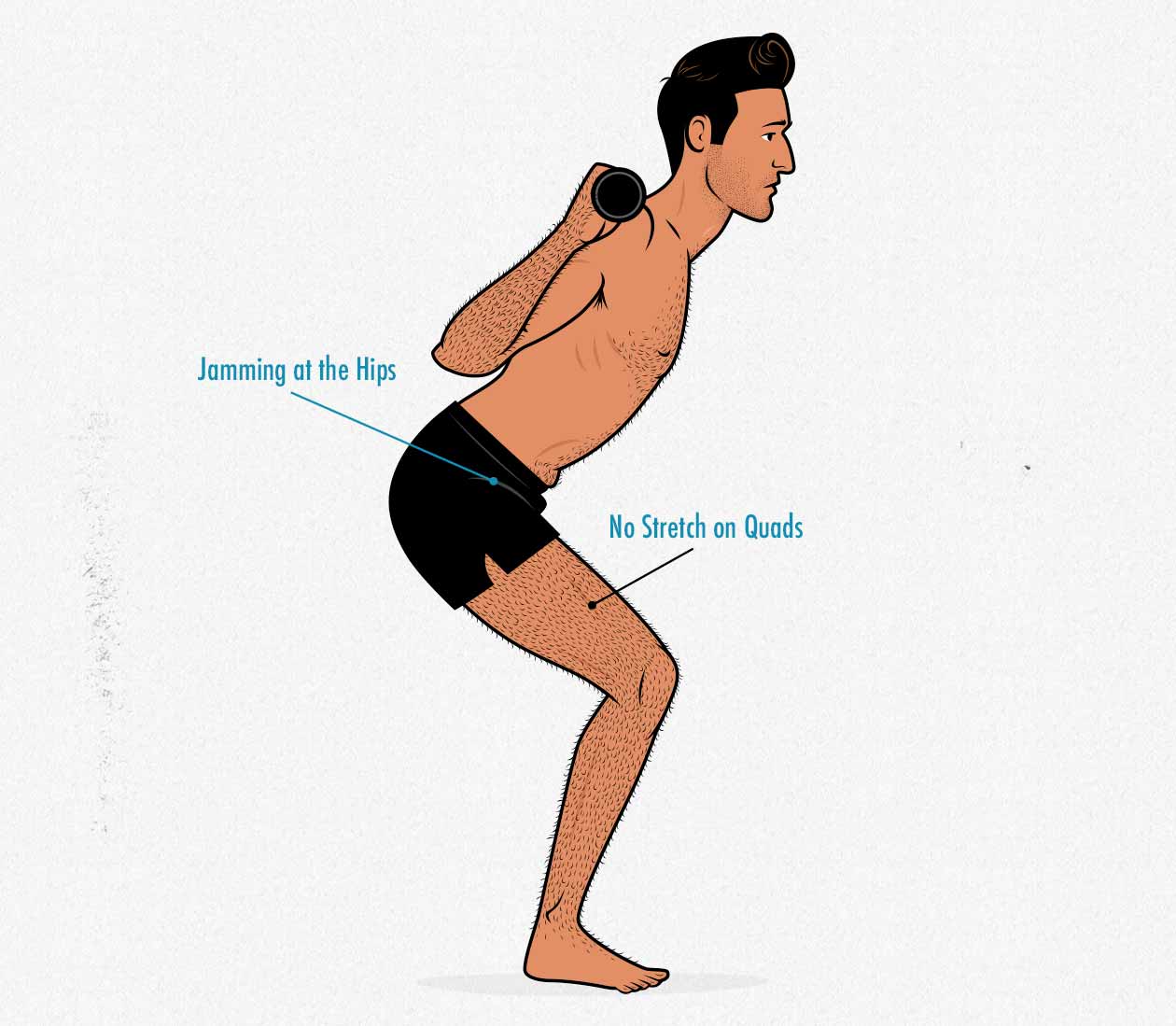
Plus, when most of us try to do a back squat for the first time, we wind up over-arching our backs, our hips tilt forward and jam up, and we aren’t able to squat very deep. To fix that, we could work on improving our low-bar squat technique. Most people can squat to parallel or a little deeper, and ectomorphs don’t have any genetic disadvantage there. But that learning process will delay our muscle growth, and it’s not the best squat variation for building muscle anyway.

If our goal is to build muscle, front-loaded squats tend to be better. They’re safer, easier to learn, they do a better job of improving our posture, they work our quads through a deeper range of motion, and they’re fantastic for our backs. They’ll make our backs thicker and straighten out our serpentine posture. We need to use lighter weights, yes, but it’s a better lift for stimulating muscle growth.
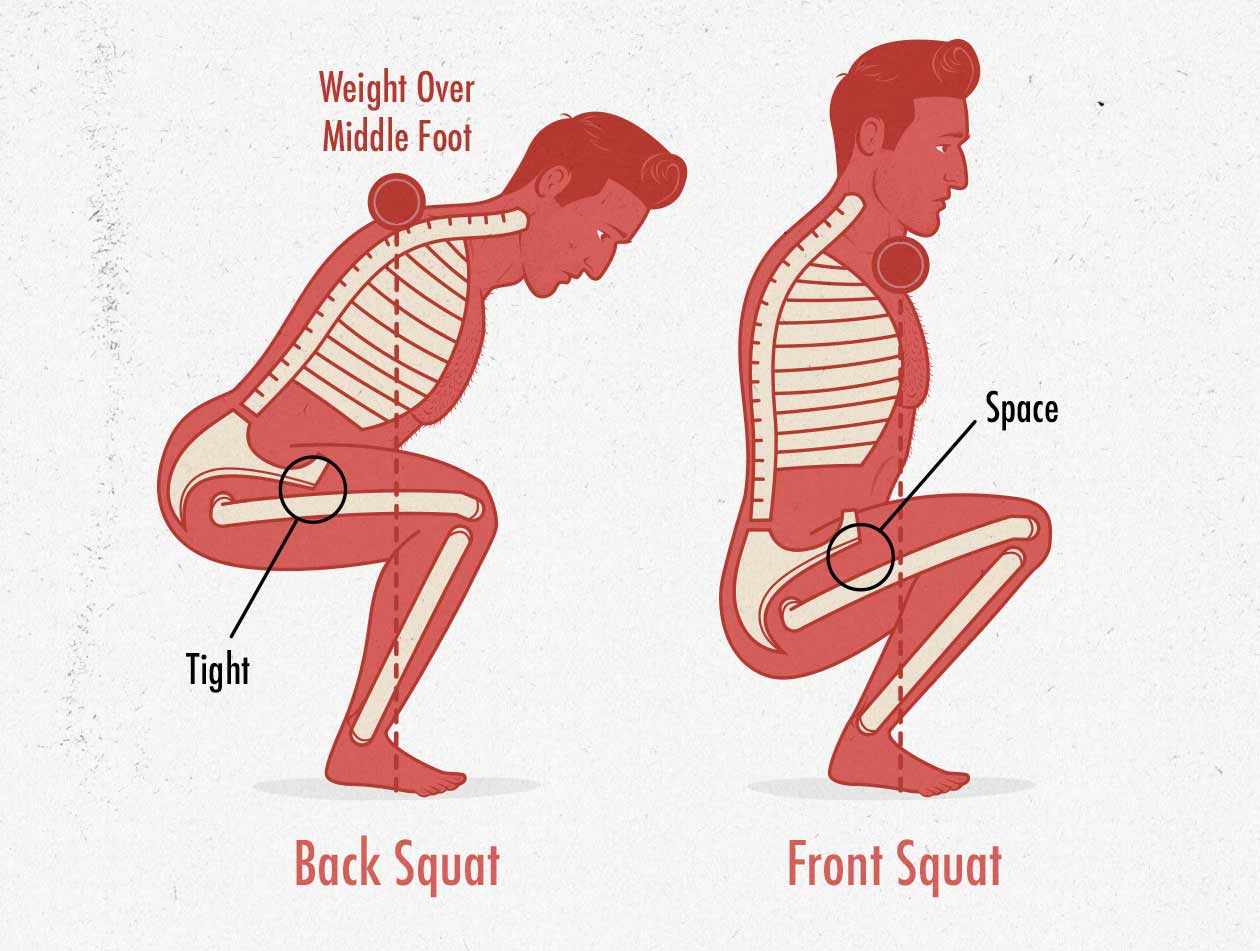
Front squats shift our centre of balance forward, allowing us to keep our torsos more upright. We can “sit down” instead of “sitting back” into our squats. This frees up space in our hips while giving our quads a deeper stretch. Holding the barbell in front of our bodies is also really hard on the spinal erectors in our upper backs, too, helping us to build a thicker and stronger torso.
The problem is, front squats are hard to learn. It’s easier to brace our cores and get a deeper range of motion, but most people don’t have enough mobility in their shoulders or wrists to hold the barbell properly. Plus, for naturally skinny guys, it can be uncomfortably to put a heavy barbell on our collarbones if we haven’t built much muscle in our shoulders and upper chests yet.
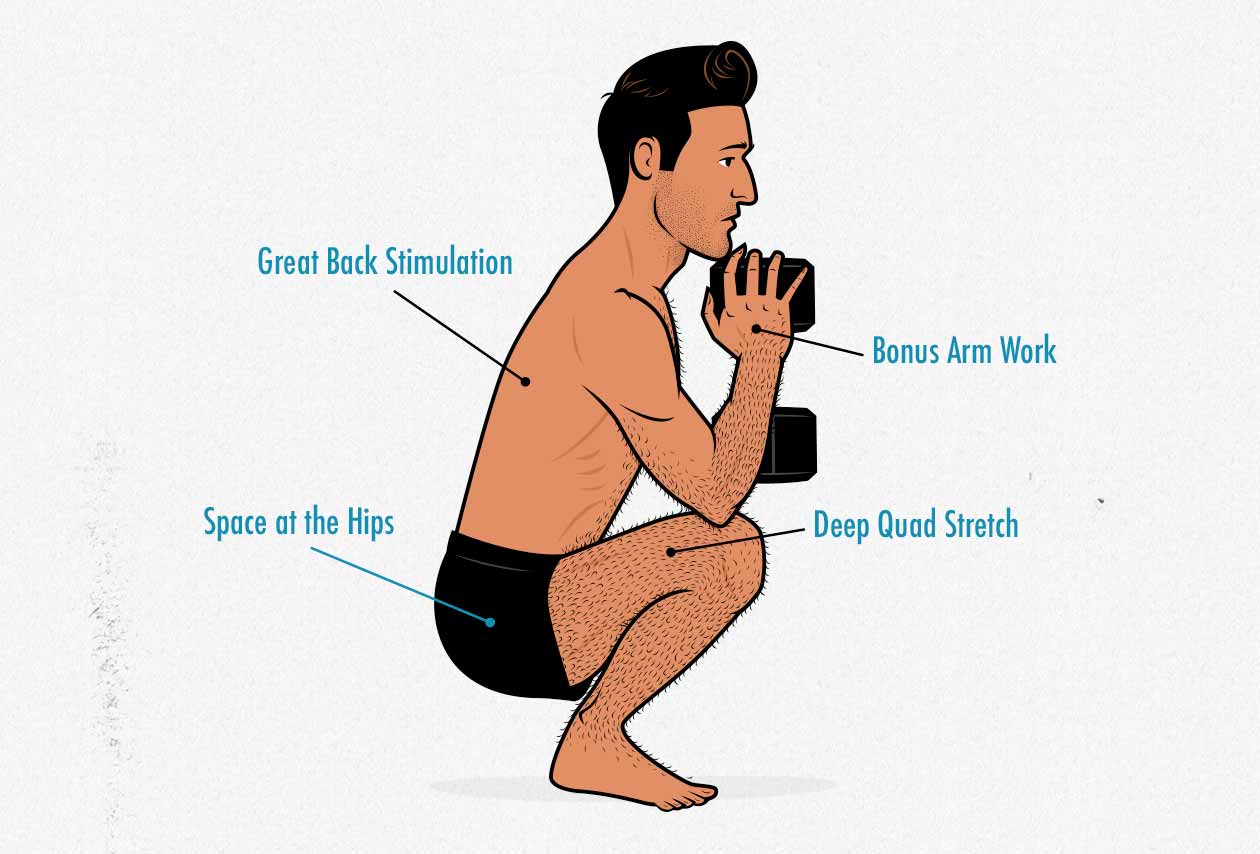
A good solution is to start with a goblet squat. It’s a simple brute strength lift that can be done with a dumbbell, kettlebell, or weight plate. It’s easy to set up, the technique is easy to learn, and it makes it much easier to squat nice and deep.
Here’s how to do a dumbbell goblet squat:
The main downside to the goblet squat is that you need to support the weight with your hands, biceps, shoulders, and upper back. But if you want to grow those muscles, too, that downside becomes a benefit. It means that the goblet squat becomes a full-body bulking lift, stimulating even more muscle growth. As a result, it may be the single best beginner bulking lift, stimulating even more overall muscle growth than the mighty deadlift.
The only real problem with goblet squats is that as you continue getting stronger, eventually you’ll be able to do 12+ reps with the heaviest dumbbell. That’s fine for building muscle, but delving into ever higher rep ranges will become increasingly hard on your cardiovascular system, and so goblet squats will become increasingly painful. They’re a brutally difficult lift once you get strong enough.
Eventually, you’ll want to switch to a front squat, back squat, or grab a second dumbbell. But in the meantime, the goblet squat is absolutely brilliant for stimulating full-body growth.
A Sample Beginner Bulking Routine
The Workouts
This is a simple full-body workout routine that works all of the major muscle groups in your body and requires just dumbbells and a bench. You don’t need to do every circuit every workout, and you don’t need to do the circuits in this order, but doing this full routine three times per week should help you stimulate a ton of muscle growth, especially during your first few weeks of lifting.
Circuit A
- Push-up: 3 sets of as many reps as you can. When you can do twenty reps on your third set, choose a more difficult variation.
- Romanian deadlift: 3 sets of 10 repetitions.
This circuit is designed to bulk up your posterior chain, abs, chest, shoulders, and triceps. You can choose any bench press or deadlift variation, but what’s nice about this combo is that we’re mixing a free weight exercise with a bodyweight exercise, meaning you only need to set up one piece of equipment.
Circuit B
- Dumbbell Bench Press: 3 sets of 10 repetitions.
- 1-Arm Dumbbell Row: as many reps as possible with the dumbbells you used for your bench press.
In this second circuit, we’re doing an agonist-antagonist superset. The bench press trains our chest and triceps, whereas the row trains the opposing muscles: our back and biceps. Antagonist supersets are great for stimulating muscle growth.
Again, you can choose any exercise variations. This particular one works well because we’re using the same bench and dumbbells for each exercise, making it quite convenient.
Circuit C
- Goblet Squat: 3 sets of 10 repetitions.
- Lat pulldown (or at-home alternative): 3 sets of 10 repetitions.
In this circuit, we’re training our quads, glutes, spinal erectors, lats, chest, and the long head of our triceps. The reason this circuit works well is that we can set up a single dumbbell for each exercise, allowing us to switch between them conveniently. (Or, if you’re doing a lat pulldown, you can bring a dumbbell over to the machine for your goblet squats.)
Circuit D (optional)
- Biceps Curls: 2 sets of 10 repetitions.
- Triceps Extensions: 2 sets of 10 repetitions
In the final circuit, we’re doing some isolation lifts to bring up muscles that we’re particularly eager to grow. Our biceps and triceps have gotten a bit of stimulation from our compound lifts, but not enough. Doing some biceps curls and triceps extensions will ensure that they grow at full speed.
You can replace these exercises with anything, though: neck curls and extensions, dumbbell flyes and reverse flyes, and so on.
How To Do The Workouts
This workout is organized into little circuits or “supersets.” The idea is to alternate between the two exercises, resting around 60 seconds between each one. For instance:
- Push-ups (set 1)
- Rest 60 seconds
- Romanian deadlifts (set 1)
- Rest 60 seconds
- Push-ups (set 2)
- Rest 60 seconds
- Romanian deadlifts (set 2)
- Rest 60 seconds
By resting between each exercise, you give your cardiovascular system a minute to recover, keeping the challenge on your muscles. By alternating between two exercises that work different muscles, you give each of your muscles around three minutes to recover before being worked again. This allows you to stimulate more muscle growth in a shorter amount of time, and as a bonus, it’s also good for your health. (These workouts are about half as efficient as dedicated cardio training, so if they take you an hour to complete, that counts as doing thirty minutes of cardio.)
You don’t need to do the circuits in order. This workout starts with push-ups and deadlifts, which is great for emphasizing growth in your back, chest, shoulders, forearms, and abs. It’s great for general strength, overall size, and aesthetics. But let’s say you were especially eager to bulk up your quads. In that case, it might be better to start with the squat circuit. That way you’re doing your squats while you’re still fresh. It’s up to you. (Leave Circuit D to the end, though. Better to save the isolation lifts for last.)
Each workout is a full-body workout that trains most of our major muscle groups. To build muscle as quickly as possible, we recommend doing them 3x per week with a day of rest in between them.
- Monday: workout 1
- Tuesday: rest
- Wednesday: workout 2
- Thursday: rest
- Friday: workout 3
- Saturday: rest
- Sunday: bonus rest
Every workout, write down what you can do. Next workout, try to beat those numbers.
It’s important to get close enough to failure. We’ve intentionally chosen lifts that are easy to learn and fairly safe to perform. That doesn’t mean we should lift recklessly, but it does mean that we should push ourselves. If you aren’t sure how close to failure you’re getting, try taking a set all the way to muscular failure. We don’t want to leave more than 1–3 reps in the tank, so it’s important to test ourselves to make sure we aren’t stopping too far away from failure.
After a few weeks, we recommend moving onto a periodized program. That way we’re progressing the exercises, the rep ranges, and the number of sets you’re doing each week. This is important because as we adapt to our workouts, we grow bigger, stronger, and also tougher, reducing the stimulus you get from your workouts but also allowing you to handle more rigorous training. If we’re increasing your training volume as your tolerance for training volume increases, it should lead to faster muscle growth over time. (Almost every hypertrophy expert recommends this approach, it works well in practice, and it makes sense mechanistically, but so far, periodization has only been proven to increase strength gains, not hypertrophy.)
Repetition helps during your first few weeks of training. It flattens the learning curve and gives you plenty of practice with each lift. As you gain more experience, you can start doing a wider variety of exercises. This can lead to more balanced muscle growth, it can reduce wear and tear on your joints, and it can help prevent muscle growth plateaus.
The Final Word
Don’t worry about getting everything perfect right away. Good technique develops gradually with practice, not before you do your first challenging set. You can gain 20–30 pounds while mastering the art of lifting. Your best is good enough.
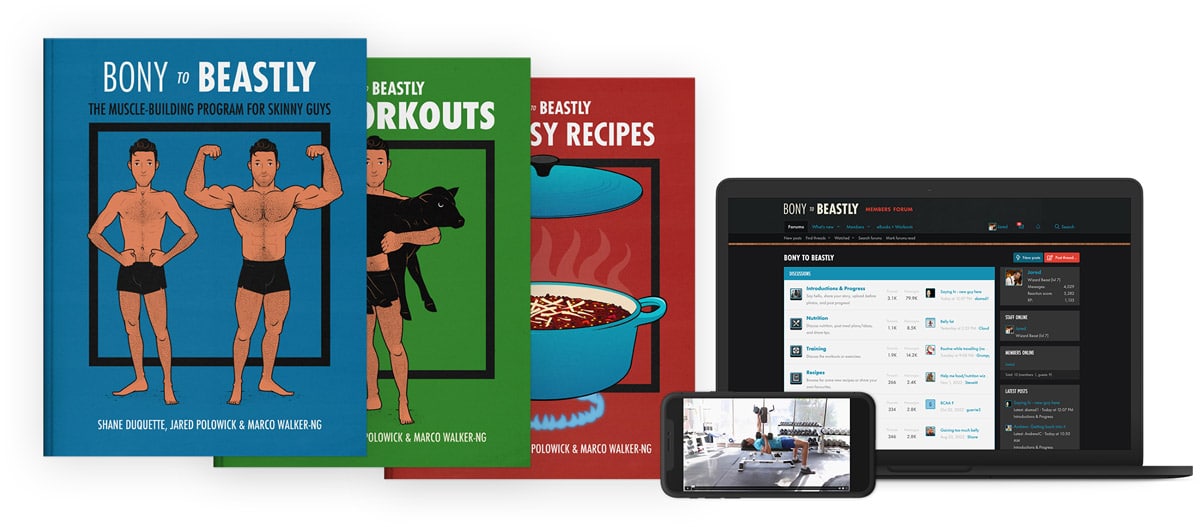
Alright, that’s it for now. If you want more muscle-building information, we have a free bulking newsletter for skinny guys. If you want a full foundational bulking program, including a 5-month full-body workout routine, diet guide, recipe book, and online coaching, check out our Bony to Beastly Bulking Program. Or, if you want a customizable intermediate bulking program, check out our Outlift Program.

